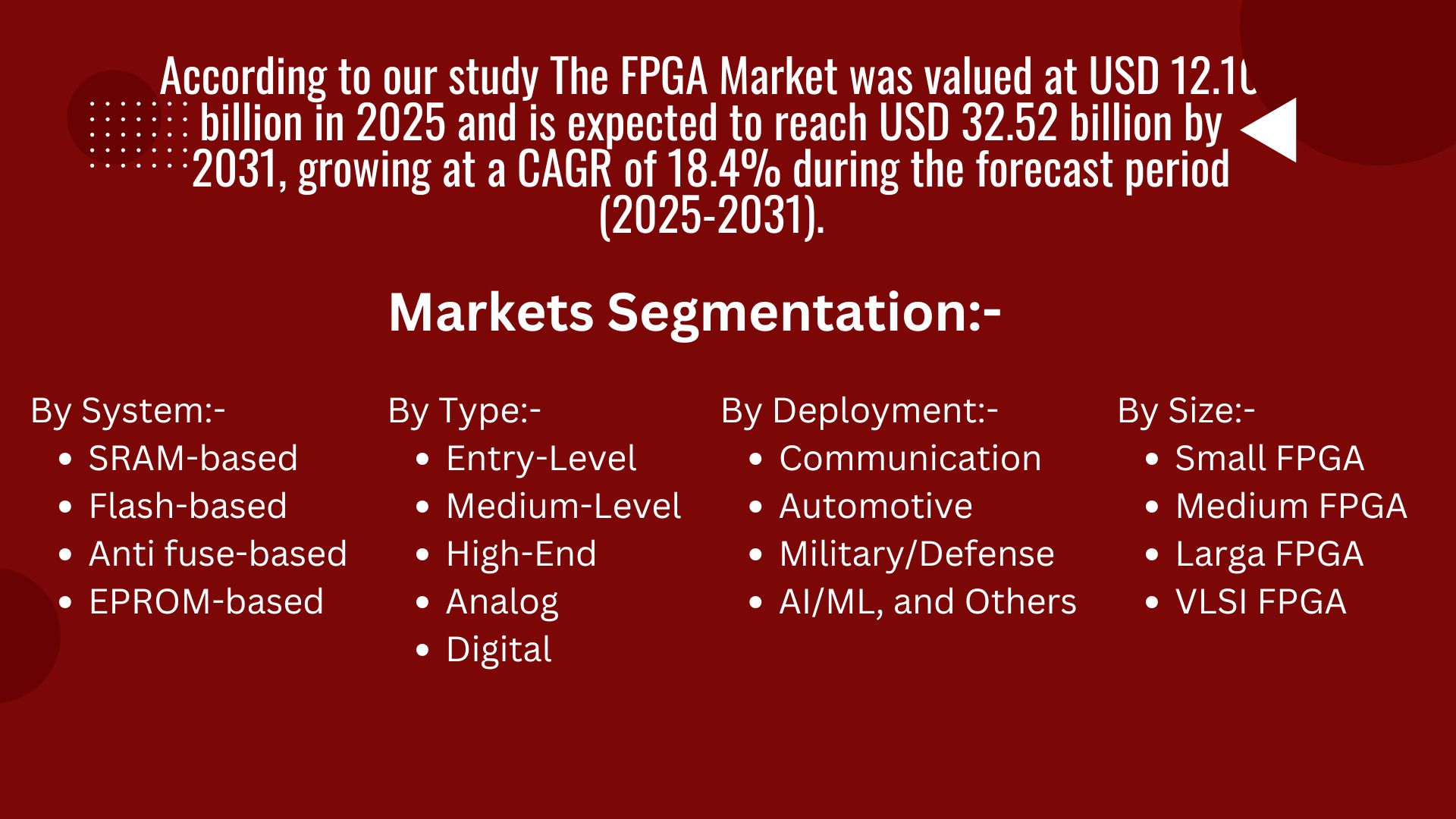Field Programmable Gate Array (FPGA) Market Analysis USD 12.10 Billion in 2025, USD 32.52 Billion by 2031, 18.4% CAGR Growth

According to our study Field Programmable Gate Array (FPGA) Market was valued at USD 12.10 billion in 2025 and is expected to reach USD 32.52 billion by 2031, growing at a CAGR of 18.4% during the forecast period (2025-2031)
The worldwide FPGA market is growing tremendously and is predicted to reach USD 32.52 billion by 2031. The FPGA market is evolving at a high pace and is shaping the technological future in ways that we could never imagine. FPGAs have received much attention due to their flexibility and effectiveness. These new devices are reconfigurable after assembly, and therefore developers can customize them for a range of applications across multiple industries.
And the FPGA has only grown in importance to the point where companies increasingly see the potential of them as we approach 2024. Whether in telecom or automotive applications, these parts help deliver performance while minimizing time-to-market and cost.
FPGA Driving Market Growth
The FPGA market is growing tremendously as consumers are looking for customizable computing products. FPGAs are becoming an industry standard as businesses increasingly want to make the most of data processing, and they do so with less effort. Technology is crucial, too. Improved manufacturing and design tools have also made it possible to develop customized FPGA solutions. This accessibility entices more businesses to take advantage of reconfigurable hardware.
Also, interest in FPGAs is driven by the emergence of artificial intelligence (AI) and machine learning (ML) solutions. They are able to run parallel jobs which is what makes them ideal for processing large
numbers of data quickly. Rising research and development spending in different sectors are opening up the market. Companies promise to keep coming up with something new, thus driving FPGA adoption across the globe.
Comparison of Different Segments of the Market
The FPGA market has many sub-sectors, each offering its own specificities. We can group systems by type including embedded systems and standalone units. Each has its own niche uses in specific fields. As far as deployment models go, both cloud and on-premises are the norm. Cloud deployments provide scalability, whereas on-premises platforms allow more resources management.
Size segmentation also constitutes a crucial part of the market. Micro enterprises (SMEs) are usually more comfortable with smaller FPGAs because they can save money, while corporations go big and buy bigger units for more advanced computing. According to end-user analysis, industries such as telecoms, automotive, and healthcare represent an abundant demand. Such industries use FPGAs for their portability and performance.
In line with emerging trends, edge computing applications will expand as well. Data processing requirements change as data processing needs change, as do the needs of the FPGA vertical.
Market Leaders and Their Approaches
The FPGA market is highly competitive with many key companies in the industry defining its boundaries. Businesses such as Xilinx and Intel lead the way, using cutting edge technology to provide cutting edge solutions. Xilinx is focused on high-performance adaptable computing and continues to expand into AI and machine learning. They provide multifunctional products across multiple industries.
In comparison, Intel pursues an approach combining traditional FPGAs with innovative hardware acceleration technologies. They primarily target inclusion into cloud architectures to improve data center performance. Other prominent contenders are Microchip Technology and Lattice Semiconductor. These companies cater to niches by offering low-cost FPGAs for consumer electronics and automotive applications. Partnerships and collaborations are frequent as businesses aim to expand the market and build product capabilities in this changing landscape. All of the players are constantly pushing boundaries, ensuring different choices for customers across multiple applications.
Future Growth Predictions and Opportunities
The FPGA market is set to witness tremendous development over the next few years. The market for configurable hardware solutions will grow as industries are shifting towards digital transformation. Emerging technologies such as 5G and AI are some of the major driving forces. Such advancements call for the type of processing speed that FPGAs can provide effectively. The versatility of FPGAs lets companies quickly adjust to evolving technologies.
New fields of applications include automotive, healthcare, and telecommunications. Organizations are adopting FPGAs into systems for enhanced performance and reduced power consumption. There are even startups dedicated to designing cool FPGAs. Their new ideas might bring innovations that transform the way markets work. There will also be an emphasis on investing in R&D. This attention can unlock untapped use cases and make FPGAs more relevant to different fields.
Market Opportunities and Threats.
There are a few challenges that may slow the growth of the FPGA market. The most pressing is the rate at which technologies are developing. To keep up, companies need to continuously create new solutions, which puts pressure on resources. Cost pressures are another potential threat. In most cases, research and manufacturing investment are required to create and implement FPGAs. Small companies might not be able to challenge the big moneyed ones.
Further, FPGA programming has a steep learning curve. Such intricacy might prevent end users from using such solutions and hinder market growth. Manufacturers are also exposed to disruptions in the supply chain. International disasters cause delays in essential components, impacting delivery and production cycles. Other technologies such as ASICs (Application- Specific Integrated Circuits) could dethrone FPGAs. All of this makes the future of this industry difficult for stakeholders to navigate in the coming years.
Regional Analysis of the Market
The FPGA market is experiencing significant growth in multiple regions and each area is driving it in a different way. North America dominates the market due to technological innovations and multiple applications in telecommunications and automobile industries. The presence of major players and high R&D activity further cement this region’s position.
Europe is not far behind, and industries are rapidly utilizing FPGAs for new applications. The high-performance computing need for aerospace and defense has driven growth here. It is also vital that government efforts to foster semiconductor production are essential. With rapid industrialization and a burgeoning electronics industry, Asia-Pacific is a clear exception. Developing nations such as China, Japan, and India are at the forefront in investments in AI-powered products using FPGAs for increased processing power. This region is expected to expand at an unprecedented pace owing to growing consumer electronics demand.
The market in Latin America is slowly coming into play as enterprises see the importance of using FPGAs within their business. Meanwhile, the Middle East & Africa present possibilities that will be driven by increased investment in digital transformation activities. Each geographic region offers unique advantages that support different requirements of the FPGA industry. While trends may change in the global arena, recognizing these regional dynamics will be important for stakeholders who want to manage this booming market well into 2024 and beyond.
Download free samples
Contact Us
- 76202 24201
- +1 212-203-7540
- sales@globaldatalooker.com

